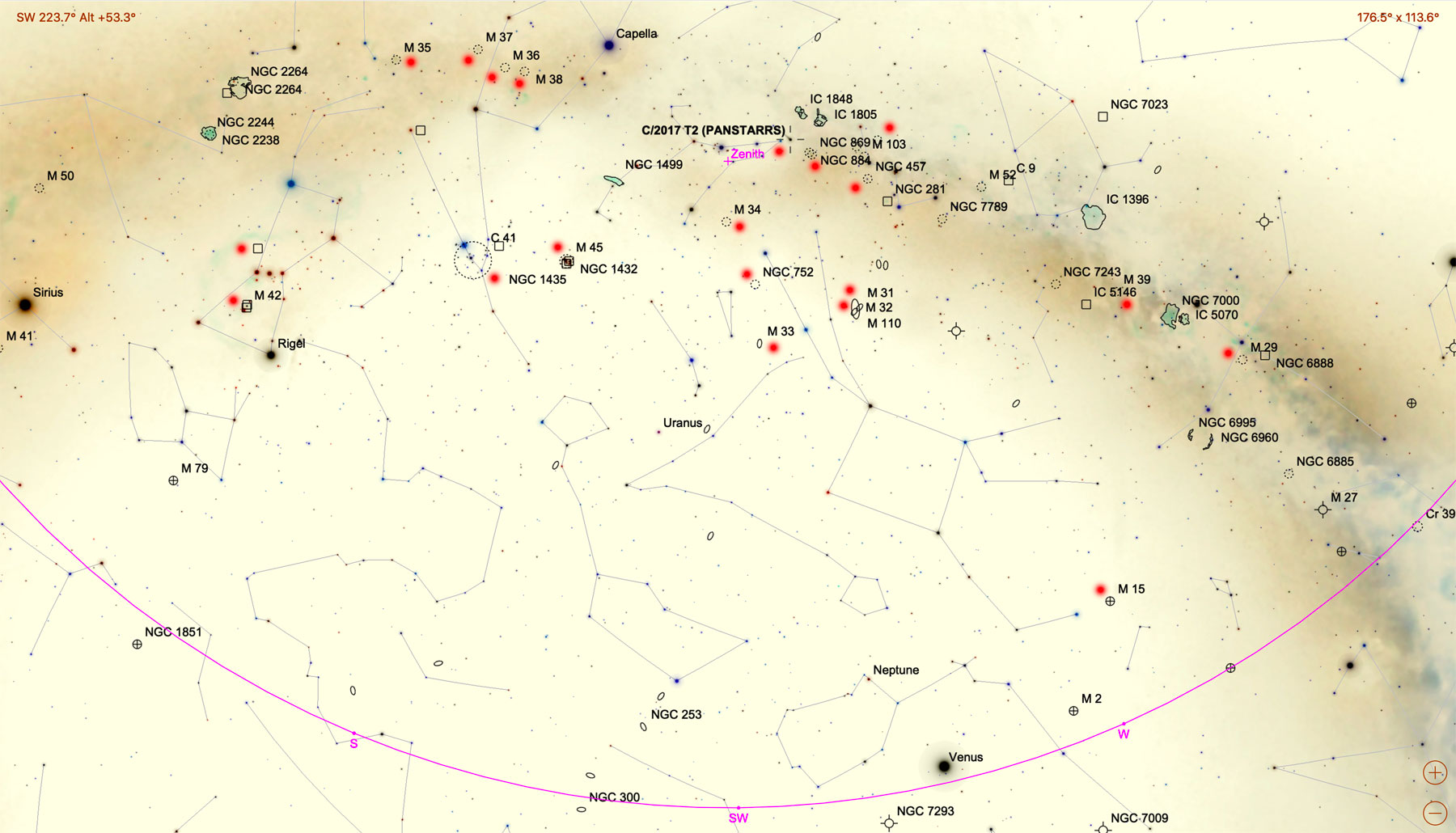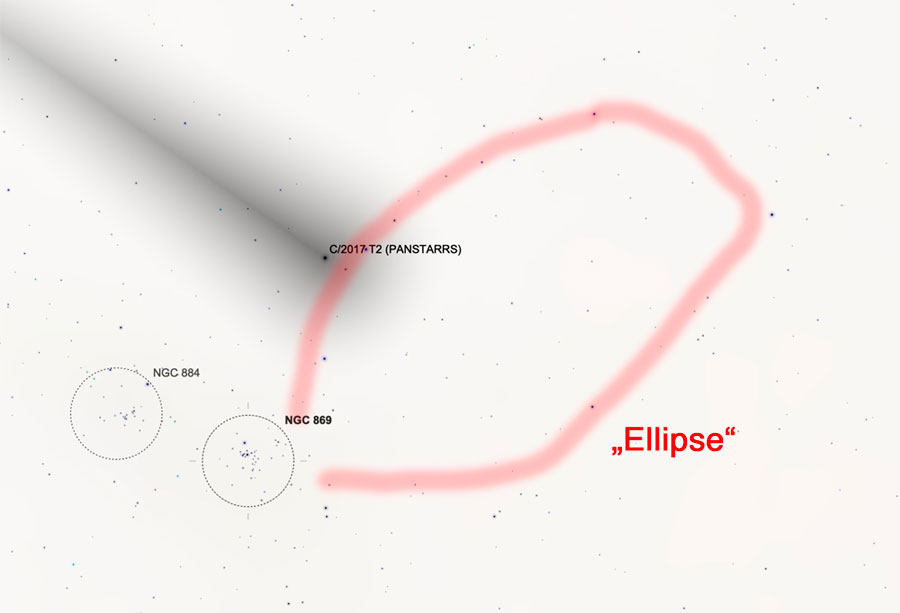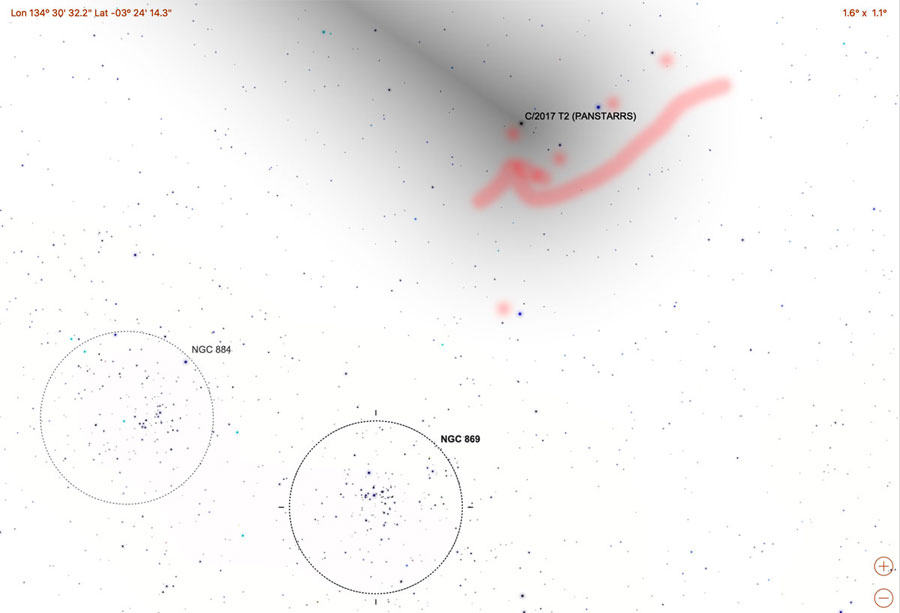Deep Sky Winter Observations End of December 2019 - End of January 2020
Conditions | Observation Overview | List of Observed Sky Objects | References
From the end of December 2019 up to the end of January 2020, I did simple "deep-sky winter observations," which might be of interest to other beginners and are therefore described here. They took place in Mühlhausen/Kraichgau and were carried out with various telescopes and with my binoculars.
Conditions
Sky Region and Objects
I observed in various sky areas as shown in the sky maps below.
Overview Maps
The following inverted map shows approximately the sky area that I primarily browsed during my observations (and some of the observed objects):
Click the map for a larger version - it opens in a new window (Image Courtesy of SkySafari Astronomy, www.simulationcurriculum.com)
Observation Time
The observations were done from the end of December 2019 to the end of January 2020.
Observation Location
Tthe observations took partly place in Mühlhausen/Kraichgau (Germany):
- Coordinates: 49° 15′ N , 8° 43′ E
- Coordinates (dec.): 49.25° N, 8.72° E
Devices Used
I used the PS72/432 and the Skymax-127 on the AZ Pronto mount,the Explorer 150PDS on the AZ4 mount, and the C8 on the Star Discovery mount and on the AZ4 mount, as well as my binoculars. I also used various of my own eyepieces.
General Conditions
In Mühlhausen/Kraichgau, the sky was not particularly dark.
Observation of the Comet C/2017 T2 (PANSTARRS) on January 29, 2020
(Images Courtesy of SkySafari Astronomy, www.simulationcurriculum.com)
Observation Overview
| Date 2019/20 |
Observed Objects | Details, Remarks | Further Observations and Remarks | Devices Used | Eyepieces Used |
| Dec 28 MH |
GC: M15 OC: M 45, M 35 GN: M42/43 Venus |
Pegasus: Taurus: Orion (later, from about 22 o'clock on): Twins / Gemini (ditto): |
Comparison of two telescopes on M 15, M 45, M 42/43 and M 35: C8, and
Skymax-127
Venus in the C8 colorful and fuzzy, but maybe half (40, 28 mm)... |
C8 on AZ4 mount, Skymax-127 on AZ Pronto mount | C8: 40, 28, 16, 10, 7 mm SM127: 24, 16, 10, 7 mm |
| Dec 29 MH |
GC: M 15
Crescent of the Moon |
Crescent of the Moon: The least contrast in the SM127, the
most contrast in the
C8; Astrid liked the SM127 anyway; I liked the C8
best, then the Explorer 150PDS; later on, details were visible in the
ash grey section of the moon, best in the C8, then less clear in the
150PDS, and weakest in the SM127; Astrid probably saw more details there
than I did...
Pegasus: |
Comparison of three telescopes on the crescent of the Moon and M 15:
Skymax-127, Explorer 150PDS, and C8
It was not easy to keep all three telescopes on the moon, and even less so on M 15, but I managed to keep all three there to some extent, even on M 15. Skymax-127: A comparison of the cheap Celestron zenith mirror with the dielectric Lacerta zenith mirror showed no noticeable differences in the image (brightness, contrast). |
C8 on Star Discovery mount (motor-driven, no alignment/manually), Explorer 150PDS on AZ4 mount, Skymax-127 on AZ Pronto mount | C8: 40 mm, 10 mm, ??? 150PDS: 24, 16, 7, 4 mm, ??? SM127: 24, 16, 7 mm, ??? |
| Dec 30 MH |
OC: M 35, M 45, GN: M 42/43, M 78 |
Taurus: M 45 appeared almost better in the 150PDS, because the sky section was larger; otherwise, it was very similar in both telescopes (the Orion nebula was still in clouds) Orion: Gemini: >> All in all, the image in the C8 was more beautiful and more contrasty! |
M 45, M 42/43, and M 35 observed with two telescopes: Explorer 150PDS
and C8
Set up the telescopes after 5 pm in the beginning dark. Around half past five, fog appeared quickly; in less than half an hour it had covered the sky and stayed there for a long time... After 22 o'clock it cleared up again, but the Orion nebula was still in clouds at first, but later it was uncovered. |
C8 on Star Discovery mount (manually), Explorer 150PDS on AZ4 mount | C8: 40 (51 x), 35 mm (58 x) 150PDS: 16 mm (47 x) |
| Jan 5 MH |
OC: M 35, M 45, Mel 25 GN: M 42/43 |
Taurus: M 45 (Pleiades) looked most beautiful in 40 mm eyepiece (I also used 35, 28 mm) Mel 25 (Hyades) observed afterwards, not as impressive for me. Orion: Gemini: |
Explorer 150PDS set up after 9 p.m. to test the 2" eyepieces
primarily on the Orion nebula M 42/43. The moon was more than half, bright,
and already quite disturbing. Nevertheless, M 42/43 was quite good to
see later.
Eyepiece comparison :
Wandered around in the sky a little bit with the 40 and 35 mm eyepieces ("rich-field"). Saw a beautiful chain of stars above Gemini(?) that reminded me of Kemble's cascade. Then moved over to M 45 and Mel 25 (Hyades); moved back from time to time to the Orion Nebula... In the end, I searched for M 35, and found it with difficulty. All in all, the Explorer 150PDS convinced me with all eyepieces except for the 56 mm one! Rich-field observation seems possible, even though that was not the right day for this because of the bright moon. |
Explorer 150PDS on AZ4 mount | 56, 40, 35, 28, 24, 16, 10 mm - up to 28 mm including all are 2" eyepieces |
| Jan 16 MH |
GC: M 15 OC: M 35, M 36, M 37, M 38, M 45, NGC 884/869 GN: M 1, M 42/43, M 78 G: M 31/32, M 33 Venus |
Venus: C8 observed with 40 mm downto probably 24 mm (with gray
filter); PS72 with 24 mm downto probably 10 mm (with gray filter). All in all, Venus was better to see in the C8, with gray filter it was smaller and fainter (less color fringes). Venus obviously about a little more than half... Pegasus: Orion: Taurus: Triangulum: Andromeda: Auriga/Taurus/Gemini: Perseus: |
C8 with and without f/6,3 reducer/corrector (with = C8R) on
Star Discovery with SynScan WLAN and iPhone; 1-star alignment on Venus,
later on Aldebaran; PS72 on AZ Pronto
Aligned C8 on Venus with 1-star alignment, then I left it alone. After some time, I returned and set GoTo on M 15. The mount did not hit M 15, but was not completely off; then I corrected the position manually. Tracking worked so so, sometimes nearly well... After a 1-star alignment using Aldebaran, accessing objects worked better, especially for M 1, M 35-38... All in all, I just worked with quick-and-dirty alignment! SynScan WLAN: When the iPhone went to sleep, I did not loos the network connection, as I did with the iPad. I do not know the reason for this (I compared the settings). I was able to simply continue after I logged on to the iPhone again. I do, however, not know which impact this had on the tracking... |
C8 on Star Discovery mount (SynScan WLAN, iPhone), PS72 on AZ Pronto mount | 40, 35, 32, 24, 10, 4 mm |
| Jan 18 MH |
OC: M 35, M 45, NGC 884/869 GN: M 42/43, M 78 G: M 31/32 |
Andromeda: M 31/32: OK, but M 31 glow not much extended Perseus: Taurus: Orion: Gemini: |
Andromeda: Searched long for M 110, but did not find it.
Perseus: Searched long for comet C/2017 T2 (PANSTARRS), but did not find it. |
C8 on AZ4 mount | 40 and 35 mm |
| Jan 20 MH |
OC: M 34, M 45, M 103, NGC 457, NGC 663, NGC
752, NGC 884/869, St 2 GN: M 1, M 42/43, M 78 G: M 31/32 Venus |
Cassiopeia: NGC 457 (E.T. Cluster, 40 mm) found by accident, seen very nicely M 103 very nice this time (3 stars at the edge) NGC 663 found St 2 (Muscle Man) found, but was "one-armed"... Andromeda: Perseus: Taurus: Orion: |
Observed Venus briefly after telescope setup; fuzzy, not round...
Not found: M 33, M 110, M 76, C/2017 T2 (PANSTARRS) |
C8 on Star Discovery mount (manual) | 40, 35, 24, and 16 mm |
| Jan 24 MH |
OC: M 45, Mel 25 GN: M 42/43 |
Taurus: Found (40, 35 mm): M 45, Mel 25 (PS72) Orion: Searched for but not found : M 52, NGC 7510 (searched long for it, first with long focal length eyepiece, then with 10 mm, nothing found...), M 103, NGC 663 | Despite new moon it was too foggy; saw fine stars in the PS72, but much too bright background; nevertheless, it was not clear why NGC 7510 was not visible... |
C8 on Star Discovery mount (manual) (not used except for for observing M 42 at the end), PS72 on AZ Pronto mount |
C8: 35 mm? PS72: 40, 35, 24, 16, 10, 7, 4 (mostly with 40 mm = Rich-Field attempts) |
| Jan 29 MH |
OC: M 29, M 35, M 39 GN: M 42/43 C: C/2017 T2 (PANSTARRS) |
Cygnus: M 39 nice to see (26, 40 mm); M 29 are 6 fine stars (26, 40 mm; better witk 26) Taurus: Orion: After supper: C/2017 T2 (PANSTARRS) (see maps above) Finally M 42/43, M 45, M 35 once more, all very nice | First observations done before supper; slowly, clouds appeared (7 p.m.) After supper, another attempt at the comet. On this day, it seemed to me to be well findable in theory... We suspected a faint glimmer, this was probably a sighting (with the new 26 mm)! After that: M 42/43, M 45, M 35, all very nice |
C8 on AZ4 mount | C8: 26, 40 mm |
Bold: First observation during this observation period; all observations done in Mühlhausen/Kraichgau (MH) and Erkerode (Erk); G = galaxy, OC = open star cluster, GC = globular star cluster, GN = galactic nebula, PN = planetary nebula, P = star pattern, DS = double star
List of Observed Sky Objects
Object details can be obtained via the links to the relevant deep sky objects.
|
DSO
Details |
Name | Constellation | Type | Bino* | PS72 | SM127 | C8 | C8R | 150 PDS |
Remarks |
| C/2017 T2 | (PANSTARRS) | --- | C | yes | Very faint... | |||||
| M 1 | Crab Nebula | Taurus | GN | yes | yes | Seen only faintly | ||||
| M 15 | Pegasus | GC | yes | yes | yes | yes | Observed with various telescopes, best with C8 | |||
| M 29 | Cygnus | OC | yes | 6 fine stars | ||||||
| M 31/32 | Andromeda Galaxy | Andromeda | G | yes | Seen nicely, incuding M 32; M 110 not found | |||||
| M 33 | Triangulum Galaxy | Triangulum | G | yes | Seen only very faintly | |||||
| M 34 | Perseus | OC | yes | Distributed | ||||||
| M 35 | Gemini | OC | --- | yes | yes | yes | Observed with various telescopes, seen nicely, large | |||
| M 36 | Auriga | OC | yes | yes | Seen very nice, "distributed" | |||||
| M 37 | Auriga | OC | yes | yes | Seen very nice, fine, many stars | |||||
| M 38 | Auriga | OC | yes | yes | Seen very nice, showed a "cross" | |||||
| M 39 | Cygnus | OC | yes | Nice to see | ||||||
| M 42/43 | Orion Nebula | Orion | GN | yes | yes | yes | yes | Observed with various telescopes, very nice, but best with C8 (and UHC filter) | ||
| M 45 | Pleiades/Seven Sisters | Taurus | OC | yes | yes | yes | yes | yes | Observed with various telescopes, seen nicely, too large for the C8 | |
| M 78 | Orion | GN | yes | Very faint in both telescopes; two stars helped in its identification | ||||||
| M 103 | Cassiopeia | OC | yes | Very nice this time, 3 stars at the edge | ||||||
| Mel 25 | Hyades | Taurus | OC | yes | yes | yes | Observed with various telescopes, seen nicely, far too large for the C8 | |||
| NGC 457 | Owl Cluster , E.T. Cluster | Cassiopeia | OC | yes | Seen very well | |||||
| NGC 663 | Cassiopeia | OC | yes | Seen well | ||||||
| NGC 752 | Andromeda | OC | yes | Very large | ||||||
| NGC 884/869 | Perseus Double Cluster | yes | Seen nicely, but nearly too large seeing both in parallel with the C8 | |||||||
| St 2 | Muscle Man | Cassiopeia | OC | yes | Found, but had only one arm... |
*) LT = 10 x 25 binoculars, TS = 10 x 60 binoculars; G = galaxy, OC = open star cluster, GC = globular star cluster, DS = double star, P = star pattern, GN = galactic nebula, PN = planetary nebula, MW = Milky Way, C = comet
References
Books
- Michael Feiler & Philip Novak (2023). Deep Sky Reiseatlas (5. Auflage), Oculum Verlag (ISBN 978-3-949370-04-5)
www.oculum-verlag.de/detailview?no=608 - Ronald Stoyan (2021). Deep Sky Reiseführer (6. Auflage), Oculum Verlag (ISBN 978-3-938469-72-9)
www.oculum-verlag.de/detailview?no=603 - Erich Karkoschka (2022). Atlas für Himmelsbeobachter, Kosmos Verlag (EAN: 9783440173602)
www.kosmos.de/de/atlas-fur-himmelsbeobachter_1074889_9783440173602
On this Website
- Overview of Observations
- DSO List (Collected from Books)
- Omegon Photography Scope 72/432 ED OTA Information (2.8" Refractor)
- Sky-Watcher Skymax-127 OTA Information (5" Maksutov-Cassegrain)
- Sky-Watcher Explorer 150PDS Information (6" Newton)
- Celestron C8 OTA Information (8" Schmidt-Cassegrain)
- Sky-Watcher AZ Pronto Mount Information
- Sky-Watcher AZ4 Mount Information
- Sky-Watcher Star Discovery AZ GoTo Mount Information
- My Binoculars
- My Starfield Binoculars
| 28.04.2024 |


